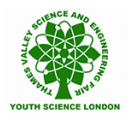Safety Rules for Exhibitors
The Thames Valley Science & Engineering Fair follows the similar safety rules as the Canada Wide Science Fair. When assessing the hazards of exhibits, the exhibitors should ask themselves the question, “Could a viewer — particularly a small child — touch or spill materials and hurt himself?” If so, additional safety precautions will be required.
It is essential that safety to the public be a prime consideration. Suitable precautions must be taken to help ensure that serious consequences do not result in terms of personal injury, property damage, or legal action. All exhibits MUST conform to the following standards which will be rigidly enforced by the Safety Officer.
- FIRE SAFETY
- Operation of an open flame, candle, torch or any other heating device is not permitted.
- Packing material shall not be stored under tables.
- ELECTRICAL SAFETY
- Electrical cords shall have a 3-wire conductor with ground and must be CSA approved and in good repair.
- Power bars, lighting and other electrical devices shall be CSA approved.
- Any modification to an electrical device negates the CSA approval and that device must not be used.
- Dry cells (Alkaline, NiCad, NiMH, LiIon, etc.) and sealed lead-acid batteries (gel cells) may be used. Wet cell batteries are not permitted.
- Electrical devices constructed by finalists must comply with the following requirements to be approved for display. As they cannot be CSA approved, these devices may only be connected and operated during judging.
- Electrical devices must be protected by a non-combustible enclosure.
- An insulating grommet is required at the point where electrical service enters an enclosure.
- Electrical devices shall use as low a voltage as possible.
- The electric current must be limited so as not to cause any danger or discomfort if the terminals are touched.
- A pilot light must be used to indicate when power is on.
- STRUCTURAL AND MECHANICAL SAFETY
- Exhibits must be sturdy, self-supporting and sufficiently stable to prevent accidental tipping.
- Sharp edges or corners of prisms, mirrors, enclosures and glass or metal plates that may be contacted by the public must be removed or protected to prevent injury.
- Dangerous moving parts, such as belts, gears, pulleys and blades, must be provided with a guard to prevent access to the moving parts.
- An in-running nip hazard of any part of a motor, device or thing that may be a danger shall be guarded to prevent contact with the pinch point.
- A certificate of safety inspection must be displayed if a project involves the construction or use of a boiler or pressure vessel with a capacity greater than 42.5 litres or operated at a pressure greater than 103 kilopascals. Evidence of inspection by an engineer with certification in boilers and pressure vessels should be displayed when the project involves any finalist-constructed pressure vessel, regardless of size or pressure. Such vessels may be displayed, but must not be pressurized at any time.
- Compressed gas cylinders shall not be displayed.
- Moving exhibits (e.g., radio-controlled vehicles, robots) shall be restricted to the regulation display space. The Host Committee may, at its discretion, provide an area to safely demonstrate projects that require more than the regulation display space.
- CHEMICAL SAFETY
- The following materials shall not be displayed:
- Flammable, toxic or dangerous chemicals.
- Prescription drugs and over-the-counter medications.
- Photographs or empty packages of prohibited materials may be displayed.
- The display of chemicals is discouraged; however, other substances can be used to simulate chemicals for display purposes.
- table salt can be used to simulate many chemicals, such as ammonium nitrate.
- Water can represent alcohol, ether and many other liquids.
- Molasses can be used to simulate petroleum products.
- When chemicals are simulated, they should be identified with the name of the substance they represent, preceded by the word “simulated.” Any WHMIS labels (supplier or workplace) should be attached to show understanding of safe work practices.
- The total quantity of liquids displayed at a project shall not exceed 1 litre. Photographs and/or video should be used to demonstrate processes requiring larger quantities of liquid.
- The following materials shall not be displayed:
- BIOHAZARDS
The following materials shall not be displayed:- Biological toxins.
- Cell or tissue samples including blood and blood products, except on sealed microscope slides, which may be displayed.
- Plants or plant tissue.
- Soil containing organic material.
- Cultures – photographs or simulated cultures may be used.
- HUMAN SUBJECTS
The project display may include pictures of participants if prior permission has been obtained. Projects dealing with forensic science topics must preserve the anonymity of any human victims, and project displays must avoid sensational or gratuitous, macabre images. - ANIMAL AND ANIMAL PARTS
- Live animals (microorganisms, non-vertebrate and vertebrate) shall not be displayed.
- The only parts of vertebrate animals that may be displayed are those that are either naturally shed by an animal or parts properly prepared and preserved. For example, porcupine quills (safely contained), shed snake skin, feathers, tanned pelts and hides, antlers, hair samples, skeletons and skeletal parts are permissible, while cell and tissue samples are not.
- Photographs of animals, animal parts or organs may be used on the display and in the Project Report; however, finalists and Regional Science Fair committees must be aware that other exhibitors and members of the public might find such photographs offensive. Finalists are encouraged to choose their photographs in accordance with the accepted norms of the community.
- FIREARMS, HAZARDOUS MATERIALS AND EQUIPMENT
The Youth Science Canada Policy on this topic can be found here. - QUESTIONS
Address any questions to the Safety Officer by using the Contact Us button in the footer below.
